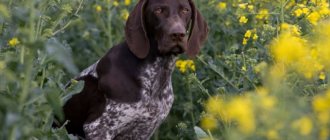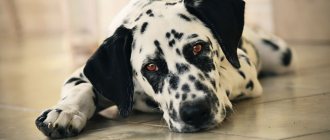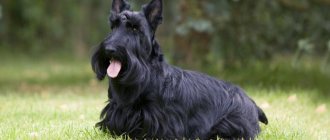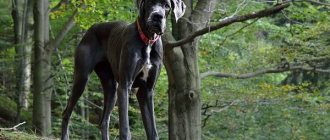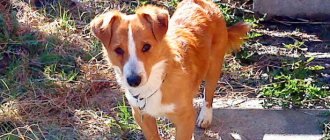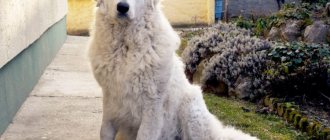/ Dogs / Dog breeds / Description of the Chesapeake Bay Retriever breed
0
1560
Article rating
Today, retrievers are best known throughout the world as family dogs, distinguished by their playfulness, affection and intelligence. However, among the six representatives of the breed, the Chesapeake Bay Retriever is the most valuable for hunters. This dog is an excellent duck hunting companion, and there are a number of factors in its favor that require more detailed consideration.
Chesapeake Bay Retriever
History of the breed
The Chesapeake Bay Retriever is one of the few breeds that originated in the United States. The breed is believed to have originated from two Newfoundland dogs that were on a ship bound for England in 1807. The ship ran aground and the entire crew, including the dogs, were rescued. Then one of the sailors found a new home for the dogs, where they grew up.
Both dogs gained a reputation as excellent swimmers, especially when it came to duck hunting. Their puppies inherited their unusual characteristic - unusual yellowish or amber colored eyes. The breed was recognized in Baltimore in 1877 and was first called the Chesapeake Bay Duck Dog.
A little later, in 1884, the American Kennel Club was created. By that time, a standard had been developed for the Chesapeake, and the breed itself had become well known for its hardiness and ability to work in icy waters. The first Chesapeake Bay Retriever Club was created in 1918 in the USA. Significantly, the front door at the Chesapeake Bay Maritime Museum in St. Michael, Maryland, was guarded by a pair of cast iron statues of Chesapeake Bay Retrievers.
Historical reference
The Chesapeake Bay Retriever is one of the representatives of the group of gun dogs. It is interesting that only this breed was bred in the USA and has several distinct breed characteristics. There is no information about the ancient representatives of the breed or its aboriginal origin, so it is believed that the Chesapeake Bay Retriever was obtained by mating retrievers and other hunting dogs.
This is interesting! The name of the breed comes from the place where it was bred - the coast of the Chesapeake Bay.
With the fog shrouding the history of the breed, the Chesapeake Bay Retrievers are widely referenced in the literature on sporting and hunting dogs. The breeding trend for this breed arose out of necessity; hunters wanted duck dogs that could work in cold water. Several nurseries arose on the coast of the Chesapeake Bay and nearby islands, through whose efforts the population increased.
By the middle of the 19th century, the Chesapeake Bay Retriever was known in America and the world, but these dogs had not been seen with their own eyes. The interest was so strong that hunters came to the breed’s homeland to see the four-legged animals in action, and if they were lucky, to work with them.
During this period, nurseries showed the world the most famous producers and representatives of the breed. Chesapeake Bay Retrievers began appearing as guests at working trials and dog shows. The efficiency and harmonious physique did not leave experts indifferent and the breed had very good chances for development. Along with success, there was also a negative factor - the dogs emitted a strong odor, which made them undesirable guests in city apartments.
Chesapeake Bay Retrievers entered into an unequal fight with their blood competitors, the Retrievers. Today we see that the battle was lost, but perhaps it is for the better. The Chesapeake Bay Retriever is a very specific dog that must work, it occupies its niche, giving way to the “family unit” of Labrador Retrievers.
This is interesting! For unknown reasons, in one of the largest Chesapeake Bay Retriever kennels in the 20th century, all breeding records were destroyed.
Character of the Chesapeake Bay Retriever
True Chesapeakes have a bright and cheerful personality, which is combined with courage, intelligence and alertness, making them excellent guard dogs. They can also have their own minds and need firm and consistent socialization and preparation for adulthood. Don't let him do something "just once" or you'll spend days or weeks repeating or retraining. All it takes is a sharp glance or verbal reprimand to put Chesapeake in his place, a harsher punishment would be overkill and would only worsen his mood and make learning more difficult.
Chesapeakes are generally intelligent and obedient dogs, they are trainable and can please you with results, although they are a bit slow to learn. These dogs are friendly and get along well with children. Dogs of this breed have a real passion for water and love swimming. Chesapeakes will also get along with cats that already live in your home, but they may chase other cats. Chesapeake Bay Retrievers are not recommended for inexperienced dog owners.
The owner must be sure that he has natural authority over the dog. If possible, this breed should attend an obedience training class. Chesapeakes can have quite dominant personalities, so they may develop various dominance issues if they perceive that their owners are passive or timid.
Proper socialization is extremely important for the Chesapeake Bay Retriever. Introduce your puppy to as many other dogs as possible. Generally, Chesapeakes are more powerful than other retrievers. Without proper guidance, they may become too dominant, aggressive, and unable to get along with other dogs. Chessies have powerful fangs and jaws that also require proper training and management.
Types, breed standard
Summary table of characteristics:
It is generally accepted that the Chesapeake Bay Retriever became a direct descendant of the small Newfoundlands, plus retrievers, setters and water spaniels were mixed in the blood. The pedigree of the first representatives of the breed was hidden by the breeders, and later burned down in a fire. When the Chesapeake received worldwide recognition, a description of the Chesapeake Bay Retriever breed was prepared. The final standard was adopted in 1878.
- Country: USA;
- height – 53-61 cm (females) and 58-66 cm (males);
- weight – 25-32 kg (females) and 29-36 kg (males);
- general description – a large dog, shows a strong physique, an intelligent look stands out;
- the body is strong, balanced, powerful. The rectangularity of the body is pronounced: the height at the withers is less than the length of the body. The back is short and powerful. The chest is massive, deep, reaching to the shoulder blades. The neck is muscular, cone-shaped and short. This shape allows the dog to carry heavy things;
- tail – straight or slightly curved. Raised up, not thrown over the back or side;
- The head is round with a wide skull and powerful jaws. The muzzle tapers towards the end. Powerful jaws are capable of neatly holding large game. The bite is ideally scissor-shaped, but straight is allowed. The eyes are light brown, clear shade and medium in size. The lips are pressed tightly to the jaws. The nose is small. The ears are set high, small and thick, the shape protects from water while swimming;
- limbs – the front ones are straight, set parallel to each other. They don't look weak. The hind limbs are more powerful so that the dog can pursue prey on land or water. Length – medium size. The movements are smooth, sweeping, with a good push;
- the coat is short, coarse and wavy on the outside, the undercoat is dense and thick, lubricated with a specific waterproof fat that protects against the cold. The hair curls slightly on top, protecting the dog from moisture. Long feathering on the tail;
- The color is monochromatic, closer to the natural environment where the dog works. Any shade of dried grass or sedge will do, preferably without white spots, although small patches are acceptable (on the chest and fingers). Black color is not acceptable;
- bite – scissor bite. Not desirable, but direct is allowed;
- ears – small, not thick, set high, hanging freely;
- life expectancy – 10 years;
- group – 8.
Maintenance and care
Chesapeake Bay Retrievers love cold climates. When it's hot, they make every effort to swim. Chesapeakes require long periods of exercise to help them relax and keep them quiet at home while you watch TV. An hour of active walking a day, or half an hour of intense exercise and water games, will be enough for them. Chessies love to swim and are extremely good at it. Chesapeakes can also be described as dogs for the suburbs, but not for the city.
Chesapeake puppies require special exercise. From 9 weeks of age until 4 months, puppies should receive training and socialization once or twice a week, as well as continuous play for 15-20 minutes with a ball or splashing in a pool. From 4 to 6 months, puppies must undergo daily obedience training. During this time, you should gradually increase the distance you walk, which should be at least 1 km by 6 months.
Chesapeakes work well with people, but they tend to be independent, or even self-sufficient. When training, use positive reinforcement methods such as praise and treats as rewards. With harsh methods, Chessies may become more stubborn and less willing to undergo training. The best way to teach your Chesapeake something new is to make learning fun and make him feel like he has a choice.
When Chesapeake does something inappropriate, like tagging in the house, you must let him know right away and tell him loudly and firmly that such behavior is unacceptable and should never happen again!
Appearance according to breed standard
The description of the appearance of Chesapeake Retrievers consists of the following characteristics:
- Head. The skull is wide and round. The eyes are medium-sized, oval-shaped, widely spaced. Their color varies from yellow to brownish. The ears are small, of medium thickness, hanging freely. The nose is compact and rectangular in shape. The jaws close like scissors, but a direct version is also acceptable.
- Neck. Powerful, cone-shaped.
- Frame. The back is shortened and muscular. The chest is deep, wide, and cylindrical. The tail is thick, weighted, straight or curved.
- Limbs. Powerful, straight, with solid bones. The fingers are rounded and tightly adjacent to each other.
- Coat. Thick, hard to the touch. The length of the guard hair is about 4 cm. The undercoat layer is compacted and woven. The hair on the face and limbs is shorter than on the body. The coat of Chesapeake Bay Retrievers is water-repellent.
- Color. The coat color of these dogs adapts to their working environment. It comes in all shades of brown and marsh. A solid color is most preferred.
Chesapeake males reach a height of 58–66 cm and weigh from 29 to 36 kg, the average height of a female is 53–61 cm, weight is 25–32 kg. The photo shows an image of a typical representative of this breed.
Key Features
- Chesapeake Bay Retrievers require a lot of exercise, including swimming if possible.
- The breed is prone to dominance issues, so the dog must be properly trained and socialized.
- Chesapeakes have a specific wool smell.
- Chesapeakes are not suitable for inexperienced or novice dog owners.
- These dogs can be aggressive towards other dogs
- Chesapeake Bay Retrievers are more aggressive and alert to strangers than other retrievers.
- Chesapeakes are strong dogs that mature quite slowly and are prone to territorial aggression, so they can be excellent guard dogs.
Who is it suitable for?
The character of the independent Chesapeake Bay Retriever is characterized by independence. The dog simply needs it when searching for game, because no one will tell it how to find downed prey. To properly raise a Chessie, you need a strong hand and unquestioned authority. Therefore, the owner of the breed should be an experienced dog lover, preferably a hunter.
Retriever puppies need to be socialized as early as possible: introduced to a large number of other dogs, other animals and people, and taken with them to visit places other than their permanent home conditions.
The wool lubricant inherent in the breed has a specific odor. Considering this factor and its considerable size, the best living conditions for a dog are a country house with a courtyard. Here it is easier to realize the potential of an animal that needs more space for active games and jogging. A Chesapeake Bay Retriever can do a lot of damage to an apartment without having an outlet for its energy. This breed is unlikely to be suitable for a passive owner who does not give the retriever proper exercise.
We suggest you familiarize yourself with: American Shorthair cat - kisa.su
Chessie is recommended for families with older children, with whom the breed gets along well. However, contact between young children and the retriever must be supervised.
The character of a retriever, if it is properly trained, is friendly, accommodating, playful, persistent when searching for game. If other dogs hunt for the owner, then the Chessie has this property of nature: be sure to find and bring. At the same time, an intelligent animal does not finish off the game and does not eat it.
Animal character, education and training
These dogs have very high performance, amazing endurance, fearlessness, balance and amazing ingenuity. Such dogs are characterized by individualism. They are never the first to show aggression towards their brothers, but the Chesapeake will not allow themselves to be offended.
Representatives of this breed are active and cheerful. Such pets are very loyal to their owner. To realize all of these qualities, these animals require socialization and training.
In the process of training your pet, you need to show patience and endurance. It is strictly not recommended to yell or resort to coercion if something doesn’t work out for the furry student the first time - these dogs learn commands slowly. To prevent a pet with an innate hunting instinct from trying to chase smaller animals during walks, the dog must first be taught the “near” command.



